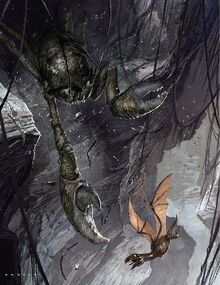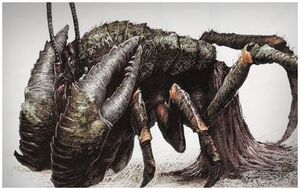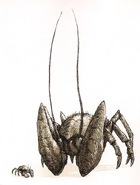|
Deplector
| |
|
Name:
|
Deplector
|
|
Abilities and Weapons:
|
size, strength, claws, senses, armour
|
|
Occupation:
|
Ambush apex predator
|
|
Home:
|
Skull Island
|
|
First Appearance:
|
"King Kong (2005 film)" (from 2005)
"The World of Kong: A Natural History of Skull Island" (from 2005) |
|
Diet:
|
Carnivore
|
|
Size:
|
Length: 3.6 meters
Weight Estimated: 620 kilograms |
|
Status:
|
Presumably extinct. Unlikely to survive Skull Island's destruction.
|
Deplectors ("Reaper") were giant crustaceans living in the cavernous crevices found along the walls of the Insect Pit. Anchoring themselves in place, they would snatch birds, bats, and other flying creatures out of the air with their six-foot long claws, using their antennae to detect prey. They were the apex predators of the Pit and among one of the largest arthropod to have ever lived.
Facts[]
While females could reach up to eight feet in length, males were scarcely larger than a newly-hatched female. They dwell in the back of the female's cavern, fertilizing their eggs and eating scraps of the female's prey.
Blind Deplectors are giant, unique, terrestrial crabs that live in the cracked and crumbling rock walls of the abyssal fissures that spider web the shattered island. Hanging in place, with their enormous pincers folded almost Mantis-style in front of them, they wait for small prey to pass the mouths of their holes. Their long antennae are sensitive to vibrations in the air, enabling them to pinpoint prey despite lacking eyes.
The most common prey are the tiny Vultursaurs that fly in thick flocks through the chasms at night, hunting moths. The hunters will find themselves prey, snatched from the air by the switchblade pincers of the Deplectors in the canyon walls. Despite a single crab taking up to a dozen of the little flying dinosaurs in a night, they make barely a dent in the vast Vultursaur numbers. When lunging, Deplectors throw all their weight into the attack, relying on elastic and stringy excretions from their abdomens to tether them to the rock, preventing a fall. At will, they can sever these sticky anchor cords to move about freely.

Mature females lay bundles of several hundred eggs in the back of their caves. The tiny white young hatch and disperse into the chasm en masse.
Of all the species on Skull Island, Deplectors exhibit the most extreme sexual dimorphism, with mature males a speck next to the giant females. The carapaces of tiny female larvae darken and harden with successive molts as they grow. A mature female can be up to eight feet in length (2.4 meters), with pincers extending a further 6 feet and antennae as long as 12 feet (3.6 meters). Males, however, remain looking like larval forms: small, pale, soft-shelled, and defenseless. They colonize the nurseries at the rear of the females’ caves, fertilizing eggs in exchange for the safety provided by their enormous landladies.
Known Victims[]
Gallery[]
Behind the Scenes[]
- Many Deplectors appeared in Peter Jackson's King Kong. When the arachnids and insectoid creatures attacked the crewmen, a man tried to climb up the cave walls, only for a Deplector to shoot its claw out of a cave and grab him before pulling him back in. When the Arachno-Claw are tugging a crewman’s body, they throw it and a Deplector catches it. One tried to attack Jimmy, but he hits its claw with his Tommy gun either wounding or killing it. When Carl Jimmy and Driscoll finish off the smaller bugs, Arachno-claws and Deplectors were about to eat them, but Eaglehorn shot from above and killed many from their holes in the wall causing them to fall down and crush other bugs below. Bruce Baxter then swung on a vine killing every one of them on sight.
- The Deplector's full body is in the book World of Kong: Natural History of Skull Island, and in the movie.
Appearances[]
- King Kong (2005 film) (first appearance)
- Skull Island: Reign of Kong (Universal, Islands of Adventure)
Trivia[]
- Like most creatures from the Pit. It is unlikely they survived the island's destruction given the sheer dangers of the Pit and difficulties of logistics in trying to garner some specimens. In contrast to the majority of the wildlife where sufficient tranquilizers would have been enough to immobilise them for study at ground-level.



